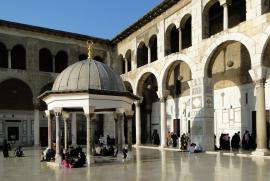To those watching from outside Syria, it quickly became clear that – despite the valiant efforts of those working in the country – Syria’s cultural heritage was being catastrophically compromised. Some of us felt that it was not enough to wait until the conflict ended before offering support – we decided to work DURING the conflict, not to wait until AFTER as many other organisations did. In 2013, at the World Archaeological Congress in Jordan (WAC-7), the idea of supporting Syrian preservation efforts gained momentum, and so we formed Heritage for Peace.
Heritage for Peace (H4P) is a non-profit, non-government organization, registered in, and runs its office from, Girona, Spain, on March 1, 2013, as an NGO under Catalan law. We are currently working on projects to save Syria’s heritage during the present crisis. Heritage for Peace’s mission is to support heritage workers as they protect their collections, monuments, and archaeological sites during armed conflict.
In addition to the (Syrian) chair, Heritage for Peace is composed of an international network of volunteers: academics, heritage professionals, and independent advisers or researchers from Syria, Australia, Germany, the Netherlands, Spain, Turkey, the United Kingdom, and the United States. We are all experts in heritage protection in conflict situations or in Syrian heritage. Presently, there are 20 people from 8 countries but the organization is growing. We work according to our expertise and availability of time. Some of us prefer to remain anonymous, and H4P respects that. Next to our international volunteers, we helped to create a network inside Syria. Although this network is also growing, the group today consists of 150 people, of which the vast majority are professionals.
Since our formation, we have engaged in continual dialogue with Syrian heritage workers of all denominations on a neutral basis – based on the Red Cross Code of Conduct (ICRC 1996) - to find ways to assist them in saving and preserving their cultural heritage during the armed conflict. It only makes sense to cover the entire domain of heritage as many emergency measures are the same (or almost the same) irrespective of the nature of the heritage. Through our heritage-protection projects we hope to foster peace. We ask all of our partners to work with us on a professional basis only, meaning that we will stay out of any political discourse whatsoever. It is only through (professional) dialogue that peace can be reached and inclusiveness can be (re-)established. Ultimately, the best protection of Syrian heritage is to reach a sustainable peace. Our work is based on extensive international experience of heritage protection, as well as substantial local knowledge of Syria, her people, and her history.
Syria’s cultural wealth is known to all. It has been the crucible of human culture for thousands of years. This rich culture includes six World Heritage sites and thousands of other sites that represent the historic, artistic, scientific, religious, and cultural values of mankind. To give just a few examples: in Aleppo, the World Heritage Ummayyad mosque came under artillery fire, destroying its ancient minaret; heavy fighting also damaged the World Heritage Crusader castle Crac des Chevaliers.
Museums at Apamea, Aleppo, Idlib and Raqqa experienced thefts, and the archaeological sites of Deir ez-Zor, Mari, Dura Europos, Halibiya, Buseira, Tell Sheikh Hamad, and Tell es-Sin (amongst many others) have been damaged by looters, who sell stolen artifacts to local and foreign dealers. Syrian heritage professionals from all sides, including the Directorate General of Antiquities and Museums, have worked valiantly to safeguard monuments, museums, and sites, but the challenges of operating during wartime require special expertise, and they cannot operate in many areas of the country for security reasons.
Our projects include:
- Creating an electronic platform containing simple and useful resources
- Preparing a “no-strike” list for the Old City of Aleppo to encourage combatants to protect the sites there
- Developing an organizational structure for our partners inside Syria to help them to co-ordinate and focus their efforts
- Designing a Risk Assessment and Protection plan for the Aleppo Museum
- Drawing up a “Resolution” for Geneva talks on Peace in Syria (January 2014) requesting all warring parties to protect Syria’s cultural heritage
- Publishing the bi-weekly “Damage Mailing List” that updates subscribers with news about damage to Syrian heritage to aid international cooperation and protection efforts
- Publishing a report on international actions titled Towards a Protection of the Syrian Cultural Heritage: A Summary of the International Responses, also designed to facilitate international co-operation
- Running training programs on:
a. Basic Tools to Protect Cultural Heritage in Syria Now
b. Evacuation: Handling, Packaging, and Storing
c. Damage assessment.
d. (International) Heritage Law
e. Heritage awareness inside refugee camps
Heritage for Peace needs assistance to continue its work in support of Syrian cultural heritage. Knowledgeable and experienced volunteers are needed, as is funding. You can support our network by donating to our organization.
For more details of our work, and information on how to donate, please refer to our website www.heritageforpeace.org or contact us at [email protected].


